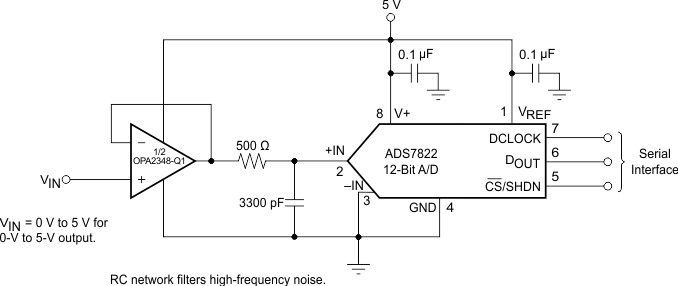-
OPAx348-Q1 1-MHz 45-µA CMOS Rail-to-Rail Operational Amplifier SBOS465C January 2009 – January 2016 OPA2348-Q1 , OPA348-Q1 , OPA4348-Q1
PRODUCTION DATA.
-
OPAx348-Q1 1-MHz 45-µA CMOS Rail-to-Rail Operational Amplifier
- 1 Features
- 2 Applications
- 3 Description
- 4 Revision History
- 5 Pin Configuration and Functions
- 6 Specifications
- 7 Detailed Description
- 8 Application and Implementation
- 9 Power Supply Recommendations
- 10Layout
- 11Device and Documentation Support
- 12Mechanical, Packaging, and Orderable Information
- IMPORTANT NOTICE
OPAx348-Q1 1-MHz 45-µA CMOS Rail-to-Rail Operational Amplifier
1 Features
- Qualified for Automotive Applications
- AEC-Q100 Qualified With the Following Results:
- Device Temperature Grade 1: –40°C to +125°C Ambient Operating Temperature Range
- Device HBM ESD Classification Level 2
- Device CDM ESD Classification Level C4B
- Low Quiescent Current (IQ): 45 µA (Typ)
- Low Cost
- Rail-to-Rail Input and Output
- Single Supply: 2.1 V to 5.5 V
- Input Bias Current: 0.5 pA (Typ)
- High Speed: Power With Bandwidth: 1 MHz
2 Applications
3 Description
The OPAx348-Q1 series of devices are single-supply, low-power CMOS operational amplifiers. Featuring an extended bandwidth of 1 MHz and a supply current of 45 µA, the OPAx348-Q1 family of devices is useful for low-power applications on single supplies of 2.1 V to 5.5 V.
Low supply current of 45 µA and an input bias current of 0.5 pA make the OPAx348-Q1 family of devices an optimal candidate for low-power, high-impedance applications such as smoke detectors and other sensors.
The OPA348-Q1 device is available in both the SOT23-5 (DBV) and the SOIC (D) packages. The OPA2348-Q1 device is available in the SOIC-8 (D) package. The OPA4348-Q1 device is available in the TSSOP-14 (PW) package. The automotive temperature range of –40°C to +125°C over all supply voltages offers additional design flexibility.
Device Information(1)
| PART NUMBER | PACKAGE | BODY SIZE (NOM) |
|---|---|---|
| OPA348-Q1 | SOT-23 (5) | 2.90 mm × 1.60 mm |
| SOIC (8) | 4.90 mm × 3.91 mm | |
| OPA2348-Q1 | SOIC (8) | 4.90 mm × 3.91 mm |
| OPA4348-Q1 | TSSOP (14) | 5.00 mm × 4.40 mm |
- For all available packages, see the orderable addendum at the end of the datasheet.
Noninverting Configuration Driving ADS7822

4 Revision History
Changes from B Revision (December 2014) to C Revision
- Added the OPA348-Q1 SOIC (D) package option to documentGo
Changes from A Revision (January 2009) to B Revision
- Added two new applications to the Applications section Go
- Added the ESD Ratings table, Feature Description section, Device Functional Modes section, Application and Implementation section, Power Supply Recommendations section, Layout section, Device and Documentation Support section, and Mechanical, Packaging, and Orderable Information section Go
- Added the OPA348-Q1 device to the data sheet Go
- Changed the name for pin 3 in the PW (TSSOP) package drawingGo